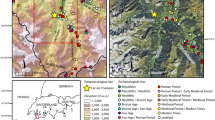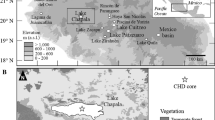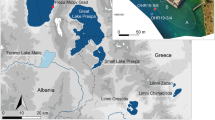Abstract
Here, we present a palaeoecological study from the Valdai Hills to examine the Holocene dynamics of forest and lake ecosystems as apparent from the isolated Lake Chernoye, which developed on an island within the greater Lake Seliger middle of the East European Plain, Russia. Palaeobotanical (plant macrofossils and pollen), geochemical and quartz grains analyses, complemented with radiocarbon dating, were carried out on a 370-cm-long sediment core. Our study involves a period between ca. 11,000 and 2100 cal. yr BP, with four main results: (1) The development of Lake Chernoye began in ca. 11,000 cal. yr BP, after the melting of buried dead-ice blocks intensified by the Early Holocene warming. As pioneer plants, Chara sp., Isöetes and C. demersum, appeared in the water with a high Ca and Mg content. High values of Pinus, Artemisia, Betula nana and Chenopodiaceae pollen may indicate the remains of cold flora that have occurred in the Younger Drays in this region. (2) Between 8000 and 6500 cal. yr BP, water level decreased as apparent from a sediment hiatus. This may be connected with the Holocene thermal maximum and final melting of the buried dead-ice block. Lower water level at that time is documented by the spreading of Najas marina, N. flexilis and Potamogeton pusillus, which are all submerged plants growing in eutrophic shallow water. Significant changes in the forest ecosystem also took place in this time frame: an increase of Quercus, Corylus and Alnus was accompanied by a decrease of Pinus. (3) A decrease in deciduous tree pollen (Ulmus, Quercus, Tilia) and an increase in coniferous tree pollen (Picea and Pinus) at ca. 4200 cal. yr BP and ca. 2700 cal. yr BP are associated with the climate cooling documented by multiproxy records in many sites in Europe. (4) Location of the lake on the isolated island did not lead to different vegetation pattern development, since this latter is similar to the other sites in the East European Plain.







Similar content being viewed by others
References
Aleshinskaya ZV, Gunova VS, Leflat ON (1992) History of Lakes in the centre of the Russian plain. In: The history of the lakes. History of the lakes of the East European Plain. St. Petersburg, pp 168–182
Astakhov V, Shkatova V, Zastrozhnov A, Chuyko M (2016) Glaciomorphological map of the Russian federation. Quat Int 420:4–14. https://doi.org/10.1016/j.quaint.2015.09.024
Berglund BE, Ralska-Jasiewiczowa M (1986) Pollen analysis and pollen diagrams 455–484. In: Berglund BE (ed) Handbook of holocene palaeoecology and palaeohydrology. Wiley, Chichester, pp 455–484
Birks HJB, Seppä H (2010) Late-Quaternary palaeoclimatic research in Fennoscandia: a historical review. Boreas 39:655–673. https://doi.org/10.1111/j.1502-3885.2010.00160.x
Borisova O (2019) Environmental and climatic conditions of human occupation in the central East European Plain during the Middle Holocene: reconstruction from palaeofloristic data. Quat Int 516:42–57. https://doi.org/10.1016/j.quaint.2018.05.025
Bronk Ramsey C (2009) Bayesian analysis of radiocarbon dates. Radiocarbon 51:337–360. https://doi.org/10.2458/azu_js_rc.v51i1.3494
Cailleux A (1942) Les actions éoliennes périglaciaires en Europe
Davydova NN, Subetto DA, Khomutova VI, Sapelko TV (2001) Late Pleistocene-Holocene paleolimnology of three northwestern Russian lakes. J Paleolimnol 26:37–51
Feurdean A, Perşoiu A, Tanţău I et al (2014) Climate variability and associated vegetation response throughout Central and Eastern Europe (CEE) between 60 and 8ka. Quat Sci Rev 106:206–224. https://doi.org/10.1016/j.quascirev.2014.06.003
Gaidamavičius A, Stančikaitė M, Kisielienė D et al (2011) Post-glacial vegetation and environment of the Labanoras Region, East Lithuania: implications for regional history. Geol Qual 55:63–69
Gałka M, Sypniewski J, Apolinarska K (2019) Early Holocene succession of vegetation and molluscs in Lake Jaczno, East-Central Europe. Quat Int 524:31–39
Gałka M, Tobolski K, Bubak I (2015) Late Glacial and Early Holocene lake level fluctuations in NE Poland tracked by macro-fossil, pollen and diatom records. Quat Int 388:23–38. https://doi.org/10.1016/j.quaint.2014.03.009
Gałka M, Tobolski K, Kołaczek P (2012) The Holocene decline of slender naiad (Najas flexilis (Willd.) Rostk. & W.L.E. Schmidt) in NE Poland in the light of new palaeobotanical data. Acta Palaeobot 52:127–138
Gałka M, Tobolski K, Zawisza E, Goslar T (2014) Postglacial history of vegetation, human activity and lake-level changes at Jezioro Linówek in northeast Poland, based on multi-proxy data. Veg Hist Archaeobot 23:123–152. https://doi.org/10.1007/s00334-013-0401-7
Gorlach A, Hang T, Kalm V (2017) GIS-based reconstruction of Late Weichselian proglacial lakes in northwestern Russia and Belarus. Boreas 46:486–502. https://doi.org/10.1111/bor.12223
Grichuk VP (1940) Method of treatment of the sediments poor in organic remains for the pollen analysis. Probl Phys Geogr 8:53–58
Grimm E (1991) Tilia 1.12, Tilia Graph 1.18.
Grimm EC (2007) Tilia Version 1.0.1
Gunova VS, Tarasov PE, Uspenskaya ON, et al (2001) Holocene evolution of the Trostenskoe Lake and adjacent area. Vestnik-Moskovskogo Univ Ser 5 Geogr 1:61–67
Hart JK (2006) An investigation of subglacial processes at the microscale from Briksdalsbreen, Norway. Sedimentology 53:125–146. https://doi.org/10.1111/j.1365-3091.2005.00758.x
Heikkilä M, Seppä H (2003) A 11,000 yr palaeotemperature reconstruction from the southern boreal zone in Finland. Quat Sci Rev 22:541–554. https://doi.org/10.1016/S0277-3791(02)00189-0
Heiri O, Lotter AF, Lemcke G (2001) Loss on ignition as a method for estimating organic and carbonate content in sediments: reproducibility and comparibility of results. J Paleolimnol 25:101–110
Hughes ALC, Gyllencreutz R, Lohne ØS et al (2016) The last Eurasian ice sheets - a chronological database and time-slice reconstruction, DATED-1. Boreas 45:1–45. https://doi.org/10.1111/bor.12142
Immonen N (2013) Surface microtextures of ice-rafted quartz grains revealing glacial ice in the Cenozoic Arctic. Palaeogeogr Palaeoclimatol Palaeoecol 374:293–302. https://doi.org/10.1016/j.palaeo.2013.02.003
Kalińska-Nartiša E, Gałka M (2018) Sand in Early Holocene lake sediment: a microscopic study from Lake Jaczno. Est J Earth Sci 67:122–132. https://doi.org/10.3176/earth.2018.09
Kalińska-Nartiša E, Stivrins N, Grudzinska I (2018) Quartz grains reveal sedimentary palaeoenvironment and past storm events: a case study from eastern Baltic. Estuar Coast Shelf Sci 200:359–370. https://doi.org/10.1016/j.ecss.2017.11.027
Kalińska E, Hang T, Jõeleht A et al (2019) Macro- and micro-scale study and chronology of Late Weichselian aeolian sediments in Estonia, north-eastern European Sand Belt. Int J Earth Sci 108:2021–2035. https://doi.org/10.1007/s00531-019-01746-2
Kalińska E, Alexanderson H, Krievāns M (2020a) The Raunis section central Latvia revisited first luminescence results and reevaluation of a key Baltic States stratigraphic site.pdf. Geogr Ann Ser A Phys Geogr. https://doi.org/10.1080/04353676.2020a.1813982
Kalińska E, Kot R, Krievāns M (2020b) Adding another piece to North-Easterne European Aeolian Sand Belt puzzles: a sedimentary age case study of Pērtupe site, Eastern Latvia. Baltica 33:46–57. https://doi.org/10.5200/baltica.2020.1.5
Khotinsky NA (1977) Holocene of Northern Eurasia. Nauka, Moscow
Kolstrup E (2007) Lateglacial older and younger coversand in northwest Europe: chronology and relation to climate and vegetation. Boreas 36:65–75. https://doi.org/10.1080/03009480600827280
Kolstrup E (1979) Herbs as July temperature indicators for parts of the Pleniglacial and the Lateglacial in The Netherlands. Geol En Mijnbouw/netherlands J Geosci 59:377–380
Konstantinov E, Panin A, Karpukhina N, Zakharov A (2018) History of Lake Seliger (Valdai Upland, Russia): new data. In: Subetto DA, Shelekhova TS, Slukovskii ZI, Druzhinina OA (eds) Lateglacial-Interglacial transition: glaciotectonic, seismoactivity, catastrophic hydrographic and landscape changes. Excursion guide and Abstracts of INQUA Peribaltic Working Group Meeting and Excursion (International Scientific Conference and School for. Karelian Research Centre of Russian Academy of Science, Petrozavodsk, pp 78–79
Kremenetski KV, Borisova OK, Zelikson EM (2000) The Late Glacial and Holocene history of vegetation in the Moscow region. Palynology 34:S67–S74
Kuprianova LA, Alyoshina LA (1972) Pollen and spores of plants from the Flora of European Part of the USSR. Nauka, Leningrad
Kvasov DD (1975) The late Quaternary history of large lakes and inland seas of Eastern Europe. Leningrad
Lasberg K, Kalm V (2013) Chronology of Late Weichselian glaciation in the western part of the East European Plain. Boreas 42:995–1007. https://doi.org/10.1111/bor.12016
Litt T (1994) Paläoökologie, paläobotanik und stratigraphie des Jungquartärs im nordmitteleuropäischen Tiefland. Diss. Bot. 227
Mahaney WC, Kalm V (1995) Pleistocene and Holocene glacier thicknesses, transport histories and dynamics inferred from SEM microtextures on quartz particles. Boreas 24:293–304. https://doi.org/10.1111/j.1502-3885.1995.tb00781.x
Mai DH (1985) Development of the water plant and Swamp Associations of Europe from the Cretaceous to the Quaternary. Flora 176:449–511
Mangerud J, Gosse J, Matiouchkov A, Dolvik T (2008) Glaciers in the Polar Urals, Russia, were not much larger during the Last Global Glacial Maximum than today. Quat Sci Rev 27:1047–1057. https://doi.org/10.1016/j.quascirev.2008.01.015
Markov KK (1977) Sections of glacial deposits in the Central Russian Plain. Moscow University Press, Moscow
Mooney SD, Tinner W (2011) The analysis of charcoal in peat and organic sediments. Mires and Peats 7:1–18
Moore PD, Webb JA, Collison ME (1991) Pollen analysis. Blackwell scientific publications
Mycielska-Dowgiałło E, Woronko B (2004) The degree of aeolization of Quaternary deposits in Poland as a tool for stratigraphic interpretation. Sediment Geol 168:149–163
Naumenko MA, Guzivaty VV, Sapelko TV (2014) Digital morphometric models of small lakes. Proc Russ State Hydrometeorol Univ 34:26–34
Neustadt MI (1957) History of forests and paleogeography of SSSR during Holocene. Academy of Sciences of the USSR
Neustadt MI, Fedorova RV, Khotinsky NA et al (1965) Osechenskoye peatbogs (Kalinin region). In: Neustadt MI (ed) Upper pleistocene and holocene paleogeography and chronology in the light of radiocarbon dating. Nauka, Moscow, pp 81–86
Pleskot K, Tjallingii R, Makohonienko M et al (2018) Holocene paleohydrological reconstruction of Lake Strzeszyńskie (western Poland) and its implications for the central European climatic transition zone. J Paleolimnol 59:443–459. https://doi.org/10.1007/s10933-017-9999-2
Reimer PJ, Bard E, Bayliss A et al (2013) Intcal13 and Marine13 radiocarbon age calibration curves 0–50,000 years cal BP. Radiocarbon 55:1869–1887
Rinterknecht V, Hang T, Gorlach A et al (2018) The Last Glacial Maximum extent of the Scandinavian Ice Sheet in the Valday Heights, western Russia: evidence from cosmogenic surface exposure dating using 10Be. Quat Sci Rev 200:106–113. https://doi.org/10.1016/j.quascirev.2018.09.032
Robin V, Knapp H, Bork H, Nelle O (2013) Complementary use of pedoanthracology and peat macro-charcoal analysis for fi re history assessment: illustration from Central Germany. Quat Int 289:78–87. https://doi.org/10.1016/j.quaint.2012.03.031
Seppä H, Poska A (2004) Holocene annual mean temperature changes in Estonia and their relationship to solar insolation and atmospheric circulation patterns. Quat Res 61:22–31. https://doi.org/10.1016/j.yqres.2003.08.005
Smith AJE (2004) The Moss Flora of Britain and Ireland, 2nd edn. Cambridge University Press, Cambridge
Stachowicz-Rybka R, Obidowicz A (2013) The development and genesis of a small thaw lake filling the Skaliska Basin during the Late Glacial and Holocene. Acta Palaeobot 53:69–91
Stančikaite M, Daugnora L, Hjelle K, Hufthammer AK (2009) The environment of the Neolithic archaeological sites in Šventoji, Western Lithuania. Quat Int 207:117–129. https://doi.org/10.1016/j.quaint.2009.01.012
Stivrins N, Kalnina L, Veski S, Zeimule S (2014) Local and regional Holocene vegetation dynamics at two sites in eastern Latvia. Boreal Environ Res 19:310–322
Stivrins N, Liiv M, Heinsalu A et al (2017) The final meltdown of dead-ice at the Holocene Thermal Maximum (8500–7400 cal. yr BP) in western Latvia, eastern Baltic. Holocene 27:1146–1157. https://doi.org/10.1177/0959683616683255
Subetto DA, Wohlfarth B, Davydova NN et al (2002) Climate and environment on the Karelian Isthmus, Northwestern Russia, 13000–9000 cal. yrs BP. Boreas 31:1–19. https://doi.org/10.1111/j.1502-3885.2002.tb01051.x
Sukachev VN (1968) On vegetation of periglacial zones of the central parts of the Russian Plain. In: Neustadt MI (ed) History of development of biogeosoenos cover of the Central Parts of the Russian Plain USSR during the Anthropogen. Nauka, Moscow, pp 5–21
Svendsen JI, Alexanderson H, Astakhov VI et al (2004) Late Quaternary ice sheet history of northern Eurasia. Quat Sci Rev 23:1229–1271. https://doi.org/10.1016/j.quascirev.2003.12.008
Tarasov PE, Pushenko MY, Harrison SP, et al (1996) Lake Status Record from the Former Soviet Union and Mongolia: Documentation of the Second Version of the Database. Boulder, Colorado, USA
Tarasov PE, Savelieva LA, Long T, Leipe C (2019) Postglacial vegetation and climate history and traces of early human impact and agriculture in the present-day cool mixed forest zone of European Russia. Quat Int 516:21–41. https://doi.org/10.1016/j.quaint.2018.02.029
Vandenberghe DAG, Derese C, Kasse C, Van den Haute P (2013) Late Weichselian (fluvio-)aeolian sediments and Holocene drift-sands of the classic type locality in Twente (E Netherlands): a high-resolution dating study using optically stimulated luminescence. Quat Sci Rev 68:96–113. https://doi.org/10.1016/j.quascirev.2013.02.009
Velichkevich FU, Zastawniak E (2006) Atlas of the pleistocene vascular plant macrofossils of central and Eastern Europe. Part 1: pteridophytes and Monocotylendons. Instytut Botaniki im. W. Szafera, Polska Akademia Nauk, Kraków
Velichkevich FU, Zastawniak E (2008) Atlas of the pleistocene vascular plant macrofossils of central and Eastern Europe. Part 2: Pteridophytes and Monocotylendons. Instytut Botaniki im. W. Szafera, Polska Akademia Nauk, Kraków
Velichko AA, Kononov YM, Faustova MA (1997) The last glaciation of earth: size and volume of ice-sheets. Quat Int 41(42):43–51
Vos K, Vandenberghe N, Elsen J (2014) Surface textural analysis of quartz grains by scanning electron microscopy (SEM): from sample preparation to environmental interpretation. Earth-Science Rev 128:93–104. https://doi.org/10.1016/j.earscirev.2013.10.013
Wanner H, Solomina O, Grosjean M et al (2011) Structure and origin of Holocene cold events. Quat Sci Rev 30:3109–3123. https://doi.org/10.1016/j.quascirev.2011.07.010
Whalley WB, Langway CC (1980) A scanning electron microscope examination of subglacial quartz grains from camp century core, Greenland—a preliminary study. J Glaciol 25:125–132. https://doi.org/10.3189/s0022143000010340
Wohlfarth B, Lacourse T, Bennike O et al (2007) Climatic and environmental changes in north-western Russia between 15,000 and 8000 cal yr BP: a review. Quat Sci Rev 26:1871–1883. https://doi.org/10.1016/j.quascirev.2007.04.005
Wohlfarth B, Tarasov P, Bennike O et al (2006) Late glacial and Holocene palaeoenvironmental changes in the Rostov-Yaroslavl’ area, West Central Russia. J Paleolimnol 35:543–569. https://doi.org/10.1007/s10933-005-3240-4
Zieliński P, Sokołowski RJ, Woronko B et al (2015) The depositional conditions of the fluvio-aeolian succession during the last climate minimum based on the examples from Poland and NW Ukraine. Quat Int 386:30–41. https://doi.org/10.1016/j.quaint.2014.08.013
Acknowledgements
The work was supported by the State Research Program of the Institute of Limnology RAS, SPC RAS No. 0154-2019-0001 and the National Science Centre, Poland (Grant Nos. DEC-2013/09/B/ST10/01589). We would like to thank Anne Nguyen for English polishing in the manuscript.
Author information
Authors and Affiliations
Corresponding author
Rights and permissions
About this article
Cite this article
Sapelko, T., Kalińska, E., Kuznetsov, D. et al. Holocene history of the lake and forest island ecosystem at and around Lake Seliger, Valdai Hills (East European Plain, Russia). Int J Earth Sci (Geol Rundsch) 111, 1947–1960 (2022). https://doi.org/10.1007/s00531-022-02210-4
Received:
Accepted:
Published:
Issue Date:
DOI: https://doi.org/10.1007/s00531-022-02210-4




